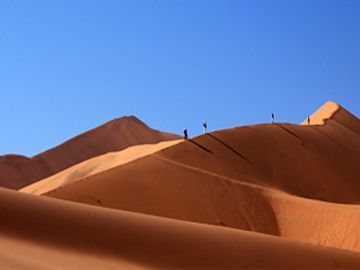The UNESCO World Heritage list informs many holiday choices, providing a world-recognised watermark for outstanding places. It’s a blue print for some, the chance to link up areas of natural beauty, historic significance or outstanding human achievements. Exodus’ diverse range of adventures have always encompassed visits to long-standing UNESCO World Heritage favourites around over the globe, from the ancient city of Petra to the plains of the Serengeti, India’s magnificent Taj Mahal to the fortifications of Old Havana. But there’s a buzz on the horizon; there something brewing at UNESCO HQ. Last month the committee convened to decide which of the world’s cultural and natural wonders would make the new additions cut for this prestigious list. The result? 19 new locations have come crashing into view, including the first ever addition from Qatar.
So now it’s time to pick our top five UNESCO newcomers…
Mount Etna It is about time this fiery giant made the cut! Encompassing almost 20,000 hectares and rising to 3,350 metres, Mount Etna covers a variety of terrains and ecosystems: summit craters, cinder cones, lava flows. Looming high over the sun-drenched isle of Sicily, the God of Fire is the most active stratovolcano in the world, puffing and steaming, bubbling and spurting, constantly reshaping the summit craters. The perfect choice for lava lovers looking for an explosive adventure!
Taking you there Treasures of Sicily
Namib Sand Sea Vast swathes of undulating, burnt ochre dunes ripple across a landscape covering over 3 million hectares. Towering, precarious sandbanks hug the Skeleton Coast, while further inland this expansive sand sea evolves into gravel plains, deep canyons and otherworldly rock formations. It is the only costal desert in the world whose dunes are shaped and shifted by fog, the primary water source for the region, and its stark beauty is bewitching.
Taking you there Discover Namibia
Mount Fuji The snow-capped summit cone of this perfectly symmetrical stratovolcano, Japan’s highest peak at 3,776 metres, is an iconic sight of any visit to the country. Whether spotted through the window of the whooshing bullet train, from the foothills in Fuji-Hakone-Izu National Park, or as far away as the bustling capital (on a clear day!), the allure of this sacred site is strong. Shrines and temples stud the ancient pilgrimage route leading to the conical summit, and unlike its Sicilian counterpart, Mount Fuji is now dormant – its last eruption recorded in the early 18th century. Commanding a prominent presence in Japanese art and literature, the mystical mountain continues to inspire poets and artists the world over.
Taking you there Ancient & Modern Japan
Hill Forts of Rajasthan In total, six of Rajasthan’s resplendent hill forts were added to the UNESCO list, including Jaipur’s red sandstone masterpiece, the Amber Fort. With the reflection shimmering on Maota Lake, it is easy to see how this hilltop royal retreat uses the landscape as its natural defences. Tucked up behind the dome-topped walls is a marble palace where a quadrant of arched courtyards, colourful frescoes, intricate marble etchings, water-cooled colonnades and tranquil gardens play guard to the secrets of the Raj.
Taking you there Highlights of Northern India
Drakensberg Park The Drakensberg is South Africa’s highest mountain range standing proud at 3,482 metres. This formidable escarpment, aptly named uKhahlamba – ‘the barrier of spears’ – by the Zulus, sprawls across 200 kilometres and covers almost a quarter of a million hectares. Basalt cliffs overshadow the riverine bush below and tens of thousands of rock paintings adorn the caves above. A haven for endemic wildlife, including numerous threatened species, the Drakensberg Park is among some of the most spectacular natural scenery anywhere in South Africa.




